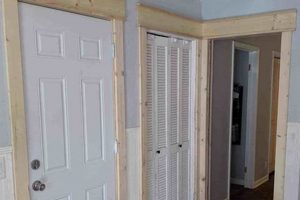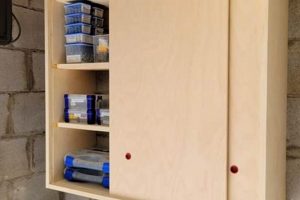The concept refers to the innovative approaches used to construct sliding doors reminiscent of those found on agricultural buildings, but adapted for interior residential or commercial spaces. This involves individuals undertaking the design and fabrication of these doors themselves, rather than purchasing pre-made units. A typical instance includes sourcing lumber, selecting hardware such as rollers and tracks, and assembling the components to create a functional and aesthetically pleasing door.
Implementing this approach offers several advantages. It allows for customization to suit specific dimensions and design preferences, potentially resulting in cost savings compared to professional installation. Historically, this door style evolved from functional necessity in rural settings to a popular design element appreciated for its rustic charm and space-saving properties. Its appeal lies in its ability to blend functionality with a unique visual aesthetic.
The following sections will explore different design concepts, material choices, and construction techniques applicable to building a door of this type. It will also offer guidance on selecting appropriate hardware and addressing common challenges encountered during the building process.
Construction Considerations
The following provides guidance for those undertaking the construction of a sliding door in the specified style. Attention to detail during each stage is crucial for a successful outcome.
Tip 1: Material Selection: Choosing appropriate lumber is paramount. Consider the wood’s density, grain pattern, and susceptibility to warping. Softwoods like pine are cost-effective but may require additional sealing and finishing. Hardwoods such as oak or maple offer increased durability and aesthetic appeal.
Tip 2: Accurate Measurements: Precise measurements of the doorway opening are essential before commencing construction. Account for any existing trim and ensure sufficient clearance for the door to slide freely along the track.
Tip 3: Hardware Compatibility: Select hardware kits designed specifically for sliding doors. Verify the weight capacity of the track and rollers to accommodate the door’s weight. Incompatible hardware can lead to functional issues and safety concerns.
Tip 4: Joint Construction: Employ robust joinery techniques to ensure structural integrity. Mortise and tenon joints, pocket hole screws, or biscuit joints provide secure connections between individual boards.
Tip 5: Surface Preparation: Thoroughly sand all surfaces before applying any finish. This removes imperfections and creates a smooth surface for paint, stain, or varnish.
Tip 6: Finishing Application: Apply multiple coats of finish, allowing sufficient drying time between each application. This protects the wood from moisture and enhances its appearance. Consider using a sealant to prevent warping or cracking.
Tip 7: Track Installation: Ensure the track is mounted level and securely to the wall studs. Incorrect installation can cause the door to bind or derail.
Tip 8: Safety Considerations: When handling power tools, wear appropriate safety gear, including eye protection and hearing protection. Work in a well-ventilated area when applying finishes.
Adhering to these guidelines will contribute significantly to the creation of a durable, aesthetically pleasing, and functional sliding door. Careful planning and execution are key to achieving a successful outcome.
The subsequent sections will provide additional information on troubleshooting common issues and maintaining the finished product.
1. Wood Selection
Wood selection is a foundational element influencing both the aesthetic and structural integrity of a door built according to the DIY principle. The chosen material dictates the visual character of the door, ranging from rustic to modern, and significantly impacts its durability and resistance to warping or decay. The decision must consider the intended environment. For example, an interior door might utilize softer, less expensive woods, whereas an exterior application necessitates hardwoods like oak or cedar due to their resistance to moisture and insect damage. This choice is a primary determinant of the door’s lifespan and long-term performance.
The relationship between wood species and construction success is direct. The density and stability of the wood affect the ease of construction and the reliability of joinery. Softwoods, while easier to work with, may require reinforcement to prevent sagging or splitting. Hardwoods, though more challenging to manipulate, offer superior strength and longevity. Furthermore, the grain pattern and inherent color of the wood influence the finishing process and overall visual impact. The selection also informs the type of hardware suitable for installation; heavier doors will need stronger tracks and rollers.
Ultimately, informed wood selection represents a critical initial investment in a DIY sliding door. Overlooking this aspect can lead to premature failure, increased maintenance, and compromised aesthetic appeal. Thorough understanding of the properties of various wood species and their suitability for specific applications is essential for a successful and durable final product. The selection of reclaimed barn wood, for example, necessitates careful inspection for structural defects and potential infestation, adding a layer of complexity to the selection process.
2. Hardware Compatibility
Hardware compatibility represents a critical determinant in the successful execution of sliding door construction projects undertaken by individuals. The selection of tracks, rollers, handles, and associated mounting components directly impacts the door’s functionality, safety, and longevity. Incompatible hardware can lead to operational difficulties, premature wear, and potential safety hazards. The weight and dimensions of the door panel must align with the load-bearing capacity of the track system to ensure smooth operation and prevent derailment. For instance, using a track system designed for lightweight interior doors on a heavy, solid-wood door could result in track failure or compromised rolling mechanism performance. Incorrect roller selection, such as using rollers not designed for the track profile, causes friction, noise, and eventual damage to both the door and the hardware. Therefore, a thorough assessment of hardware specifications and their compatibility with the intended door design is essential.
The practical significance of understanding hardware compatibility extends beyond basic functionality. It directly affects the aesthetic integration of the door within the designated space. Mismatched hardware can detract from the overall design aesthetic, while carefully chosen components can enhance the visual appeal of the door. Considerations include the style, finish, and mounting method of the hardware. For example, a rustic door design may benefit from black iron hardware, while a modern aesthetic might call for stainless steel components. Furthermore, specialized hardware options, such as soft-close mechanisms or anti-jump devices, contribute to enhanced user experience and safety. Incorporating such features requires careful consideration of their compatibility with the overall system and door design. The selection also affects the installation process; incompatible hardware necessitates modifications that can compromise structural integrity.
In conclusion, hardware compatibility is an indispensable aspect of the process, representing a direct correlation between component selection and project success. Overlooking this factor leads to functional deficiencies, aesthetic compromises, and potential safety risks. Thorough research, careful planning, and meticulous component selection are critical to ensuring a durable, visually appealing, and safely operating sliding door. The initial investment in compatible, high-quality hardware minimizes long-term maintenance costs and contributes significantly to the overall value and satisfaction derived from the project.
3. Dimensional Accuracy
Dimensional accuracy is paramount in the successful execution of sliding door projects. Precise measurements and adherence to specified dimensions directly influence the door’s functionality, aesthetic integration, and long-term performance. Deviations from accurate dimensions can lead to operational difficulties, visual inconsistencies, and compromised structural integrity, necessitating meticulous attention to detail throughout the construction process.
- Doorway Opening Measurement
Accurate measurement of the doorway opening establishes the foundational parameters for door construction. Height, width, and squareness must be precisely determined. Even minor inaccuracies can result in a door that binds, fails to close properly, or appears visually misaligned within the opening. Laser levels and precision measuring tools are recommended to ensure accurate data collection. Example: A 1/4-inch discrepancy in the doorway height can cause the door to drag along the floor or fail to properly cover the opening at the top.
- Panel Fabrication Dimensions
Precise cutting and assembly of the door panels are essential to ensure a consistent appearance and structural soundness. Ensuring all boards are cut to the exact specified length and assembled square minimizes warping and ensures the door slides smoothly. Example: If individual boards vary in length, the assembled door may appear uneven and create gaps between boards, compromising the desired aesthetic.
- Hardware Placement Precision
Accurate placement of mounting hardware, such as rollers and guide tracks, is critical for smooth operation. Incorrect hardware placement results in uneven weight distribution, causing the door to bind or derail. Example: If the rollers are not aligned parallel to the top edge of the door, the door may wobble or pull to one side when sliding, creating unnecessary stress on the hardware.
- Clearance Considerations
Accounting for necessary clearances is crucial to prevent rubbing or binding against walls, floors, or adjacent structures. Insufficient clearance results in operational impediments, while excessive clearance can detract from the visual appearance. Example: Failure to account for floor irregularities or carpet thickness may result in the door scraping against the floor, impeding its movement and potentially damaging the flooring.
The adherence to precise dimensions in each of these facets directly contributes to the creation of a functional, aesthetically pleasing, and durable sliding door. Overlooking this aspect can lead to significant rework, increased costs, and a compromised final product. Meticulous planning, precise measurements, and careful execution are essential for a successful outcome, reinforcing the importance of dimensional accuracy in all phases of construction.
4. Finishing Techniques
Appropriate surface treatments significantly enhance the aesthetic appeal and longevity of a door built using do-it-yourself methods. The selection and application of finishes directly impact the wood’s resistance to moisture, wear, and ultraviolet (UV) degradation, safeguarding its structural integrity and visual presentation.
- Staining Applications
Staining modifies the wood’s color and accentuates its natural grain patterns. The proper selection of stain depends on the wood species and the desired aesthetic. Oil-based stains offer deeper penetration and richer color, while water-based stains are lower in VOCs and easier to clean up. Uneven application leads to blotching or streaking, diminishing the overall appearance. For example, applying a dark stain to pine without a pre-stain conditioner typically results in uneven color absorption. Proper surface preparation, including sanding and cleaning, ensures uniform stain penetration and color consistency. The selection must also consider the final topcoat, ensuring compatibility between the stain and the protective finish.
- Sealing and Priming
Sealers and primers prepare the wood surface for subsequent finishing coats. Sealers prevent excessive absorption of finish, ensuring consistent color and sheen. Primers improve adhesion and provide a uniform base for paint, enhancing its durability and appearance. Applying a primer before painting is especially crucial for resinous woods, such as pine, to prevent bleed-through. The selection also depends on the chosen topcoat; for example, using an oil-based primer under a water-based paint can cause adhesion issues. Consistent application and proper drying times are critical to achieve optimal results.
- Protective Topcoats
Protective topcoats, such as varnish, lacquer, and polyurethane, shield the wood from moisture, scratches, and UV damage. These finishes provide a durable and aesthetically pleasing surface that enhances the wood’s longevity. Varnish offers excellent abrasion resistance and a high-gloss finish, while lacquer dries quickly and is suitable for intricate details. Polyurethane provides exceptional water resistance, making it ideal for doors exposed to moisture. The choice depends on the intended use of the door and the desired level of protection. Multiple thin coats, properly sanded between applications, yield a smoother, more durable finish. Incorrect application results in runs, drips, or uneven sheen.
- Specialty Finishes
Specialty finishes, such as distressing techniques, antiquing glazes, and textured coatings, create unique visual effects. Distressing simulates the appearance of aged wood, while antiquing glazes add depth and dimension. Textured coatings provide a tactile surface and can conceal imperfections. These finishes allow for customization and personalization, adding character and visual interest. However, these techniques require skill and practice to achieve a professional look. Over-application of distressing or glazing leads to an artificial or contrived appearance. Experimentation and careful execution are essential to create an authentic and visually appealing result.
In conclusion, the strategic selection and application of finishing techniques are integral to enhancing the aesthetic appeal and extending the lifespan of these doors. From staining to topcoats, each step requires careful consideration and precise execution to achieve optimal results. Neglecting or underestimating the importance of finishing diminishes the overall value and longevity of the project, underscoring the need for informed decision-making and skilled application.
5. Structural Integrity
Structural integrity, in the context of sliding doors constructed through do-it-yourself methods, represents the capacity of the door to withstand applied loads and environmental stresses without undergoing excessive deformation, fracture, or collapse. This characteristic is paramount to ensuring the safety, functionality, and longevity of the door, requiring careful consideration of material selection, joinery techniques, and load-bearing capacity.
- Material Selection and Load-Bearing Capacity
The choice of materials directly influences the door’s ability to support its own weight and resist external forces. Wood species vary significantly in density, strength, and resistance to moisture and decay. For example, using softwood for a large door panel without proper reinforcement can result in sagging or warping over time. The hardware, including tracks, rollers, and mounting brackets, must also be rated to support the door’s weight to prevent premature failure. Misalignment between the door’s weight and the hardware’s capacity presents a safety hazard and compromises the door’s functionality.
- Joinery Techniques and Connection Strength
The methods used to join individual boards or panels influence the overall strength and stability of the door. Weak or improperly executed joints can create points of stress concentration, leading to cracking or separation. Traditional joinery methods, such as mortise and tenon or dovetail joints, provide superior strength and durability compared to simpler methods like butt joints secured with screws. Selecting appropriate fasteners, such as screws or bolts of sufficient length and diameter, is crucial to ensure secure connections. For instance, using short screws to attach heavy hardware to a wooden door can result in the hardware pulling away from the door over time.
- Frame Construction and Rigidity
The frame design dictates the distribution of loads and stresses within the door structure. A well-designed frame provides rigidity and prevents racking, ensuring the door maintains its shape and slides smoothly. The inclusion of diagonal bracing or solid core construction enhances the frame’s resistance to deformation. Example: A door lacking a rigid frame is prone to warping or twisting, which can impede its ability to slide properly and create unsightly gaps. Reinforcing the frame with metal brackets or strategically placed wood members increases its load-bearing capacity and overall stability.
- Environmental Considerations and Material Durability
Environmental factors, such as moisture, temperature fluctuations, and exposure to sunlight, can significantly impact the structural integrity of the door. Wood is susceptible to expansion and contraction with changes in humidity, which can stress joints and finishes. Selecting materials that are resistant to decay and insect infestation is crucial, particularly for doors exposed to outdoor conditions. Applying protective coatings, such as sealants or paints, mitigates the effects of environmental exposure and prolongs the door’s lifespan. For example, leaving a wooden door unsealed in a humid environment promotes moisture absorption, leading to swelling, warping, and potential fungal growth.
These facets highlight the interconnectedness of design choices and construction techniques that contribute to the overall structural integrity of a DIY sliding door. By carefully considering material properties, employing robust joinery methods, designing a rigid frame, and addressing environmental considerations, individuals can create doors that are not only aesthetically pleasing but also safe, functional, and durable. Overlooking these aspects undermines the door’s long-term performance and creates potential safety risks, underscoring the importance of meticulous planning and execution.
Frequently Asked Questions
The following addresses common inquiries regarding the design and construction of sliding doors of a specific style, providing clear and concise information for optimal understanding.
Question 1: What is the typical cost associated with building a sliding door, compared to purchasing a pre-made unit?
The cost varies depending on material choices, hardware selection, and door size. Self-construction may offer cost savings, particularly when utilizing reclaimed materials. However, the investment of time and labor should be factored into the overall evaluation. Pre-made units offer convenience but often come at a higher price point.
Question 2: What tools are essential for constructing a door of this nature?
Essential tools include a circular saw, miter saw, drill/driver, measuring tape, level, and safety equipment. Additional tools, such as a planer or jointer, may be required depending on the wood preparation process. Clamps are crucial for securing joints during assembly.
Question 3: How does one ensure the sliding mechanism operates smoothly and reliably?
Smooth operation depends on selecting high-quality hardware and ensuring proper alignment during installation. The track must be mounted level and the rollers must be compatible with the track profile. Regular maintenance, including lubrication, can prolong the lifespan of the sliding mechanism.
Question 4: What type of wood is best suited for constructing a durable and aesthetically pleasing door?
Hardwoods, such as oak or maple, offer superior durability and aesthetic appeal. Softwoods, like pine, are more cost-effective but may require additional sealing and finishing. Reclaimed wood provides a rustic aesthetic but necessitates careful inspection for structural integrity.
Question 5: How can potential warping or sagging of the door be prevented?
Employing robust joinery techniques, such as mortise and tenon joints, reinforces the structural integrity of the door. Selecting kiln-dried lumber minimizes moisture content and reduces the risk of warping. Applying a sealant or protective finish protects the wood from environmental factors.
Question 6: What safety precautions should be taken during the construction process?
Safety precautions include wearing eye protection and hearing protection when operating power tools. Working in a well-ventilated area when applying finishes minimizes exposure to harmful fumes. Securely clamping workpieces prevents movement during cutting and assembly.
In summary, successful relies on careful planning, meticulous execution, and adherence to safety guidelines. Selecting appropriate materials, employing robust construction techniques, and ensuring proper hardware compatibility are crucial for a durable and functional outcome.
The following section will provide guidance on maintaining the finished product and addressing common issues that may arise over time.
Conclusion
The preceding has explored various facets relevant to individuals undertaking sliding door construction projects. Key considerations encompass material selection, dimensional accuracy, hardware compatibility, appropriate finishing techniques, and the assurance of structural integrity. Adherence to these principles directly influences the longevity, functionality, and aesthetic appeal of the finished product. The information presented provides a foundation for informed decision-making throughout the building process.
The enduring popularity of indicates a continued interest in both functional and aesthetic home improvements. Careful planning and precise execution remain paramount in achieving a successful outcome. Further research and consultation with experienced professionals is advised to address specific project requirements and ensure long-term satisfaction.







